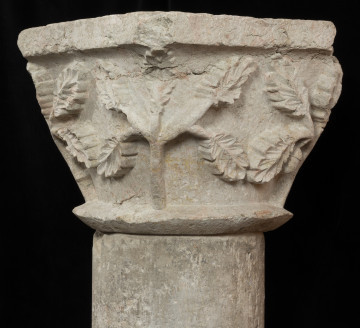
Capitol depicting meal of monks
1330 — 1340
National Museum in Szczecin
Part of the collection: Romanesque and early gothic stone capitals
The devil's capital, called this way on account of the image of the devil, characteristic for the Gotland Medieval art, belongs to a group of capitals deriving from the former buildings of the Cistercian monastery in Kołbacz. The majority of the preserved block- and bell-shaped capitals, typical for the Romanesque art, were made of limestone extracted in Gotland. The style that utilises of forms at the borderline between the Romanesque and Gothic art and the characteristic motives also relate these works to the Scandinavian island and the stonemasons’ workshops that operated there in the first half of the 14th century. The bas-relief decoration of the devil’s capital presents a genre scene with didactic and satirical elements referencing monastic life. It shows the celebration of the Eucharist at the altar, where a chalice with the Host is placed. Monks participating in the liturgy via celebration, prayer and service are presented next to the altar. The scene also refers to the adoration of the Host related to the Cistercian daily Eucharistic liturgy. The devil and the rebellious monk are pictured at the opposite side of the capital. The latter, with terror visible on his face, is trying to run away from the penalty for his sins. To no avail, as the muscular devil with a large head and donkey’s ears, grinning mockingly, is already holding his hood and dragging him closer. The presentation, which nowadays seems somewhat grotesque, exerted a moralising impact on the monks’ imagination in the past. It was a warning and an instruction to be humble, to act obediently and to pray, as this was the only path of salvation from destruction and eternal damnation. In this context, the sacrament of the Eucharist is the most efficient method of fighting with the devil’s forces.
Kinga Krasnodębska
Author / creator
Dimensions
cały obiekt: height: 37 cm, width: 52 cm
Object type
capital (architecture)
Creation time / dating
Creation / finding place
Identification number
Location / status

1330 — 1340
National Museum in Szczecin

1330 — 1340
National Museum in Szczecin

1330 — 1340
National Museum in Szczecin
DISCOVER this TOPIC
Museum of King Jan III's Palace at Wilanów
DISCOVER this PATH
Educational path